stop start SKODA FABIA 2011 2.G / 5J Owner's Guide
[x] Cancel search | Manufacturer: SKODA, Model Year: 2011, Model line: FABIA, Model: SKODA FABIA 2011 2.G / 5JPages: 220, PDF Size: 3.37 MB
Page 156 of 220

WARNING
● Never open the bonnet if you see that steam or coolant is flowing out of
the engine compartment - risk of scalding! Wait long enough until the steam
or coolant has stopped escaping.
● Switch off the engine and pull out the ignition key.
● Apply the handbrake firmly.
● If your vehicle is fitted with a manual gearbox, move the gearshift lever in-
to Neutral, or if it is fitted with automatic gearbox, move the selector lever in-
to position P
.
● Allow the engine to cool down.
● Keep children clear of the engine compartment.
● Do not touch any hot engine parts - risk of burns!
● Never spill oil and other fluids over the hot engine. Such fluids (e.g. the an-
tifreeze contained in the coolant) may ignite!
● Avoid short circuits in the electrical system - particularly on the battery.
● Never place your hand into the radiator fan as long as the engine is still
warm. The fan might suddenly start running!
● Never open the cap of the coolant expansion reservoir so long as the en-
gine is still warm. The cooling system is pressurized!
● Cover over the cap of the reservoir with a large cloth when opening it as
protection for your face, hands and arms from hot steam or hot coolant.
● Do not let objects, such as e.g cleaning cloth or tools lie in the engine com-
partment.
● If you wish to work under the vehicle, you must secure the vehicle from
rolling away and support it with suitable supporting blocks: the car jack is not
sufficient for this - risk of injury! WARNING (Continued)
● In cases where it be necessary to carry out inspection work when the en-
gine is running there is an additional risk from rotating parts (e.g. the V-ribbed
belt, alternator, radiator fan) and from the high-voltage ignition system.
Please observe in addition the following:
–Never touch the electrical cables of the ignition system.
– Absolutely avoid any jewellery, loose items of clothing or long hair from
getting into the rotating parts of the engine - Hazard! Therefore remove
any jewellery beforehand, tie up your hair and wear tight fitting clothing.
● Please also comply with the warning instructions stated below when car-
rying out any essential work on the fuel system or on the electrical system:
–Always separate the car battery from the electrical system.
– Do not smoke.
– Never carry out any work close to naked flames.
– Always keep a working fire extinguisher at hand. CAUTION
When replenishing fluids in the engine, always ensure that the fluids are on no ac-
count mixed up. This may result in major operating problems and also vehicle
damage!
Overview of the engine compartment The main inspection points.
Fig. 128 Diesel engine 1.6 ltr./77 kW
£154
Inspecting and Replenishing
Page 163 of 220
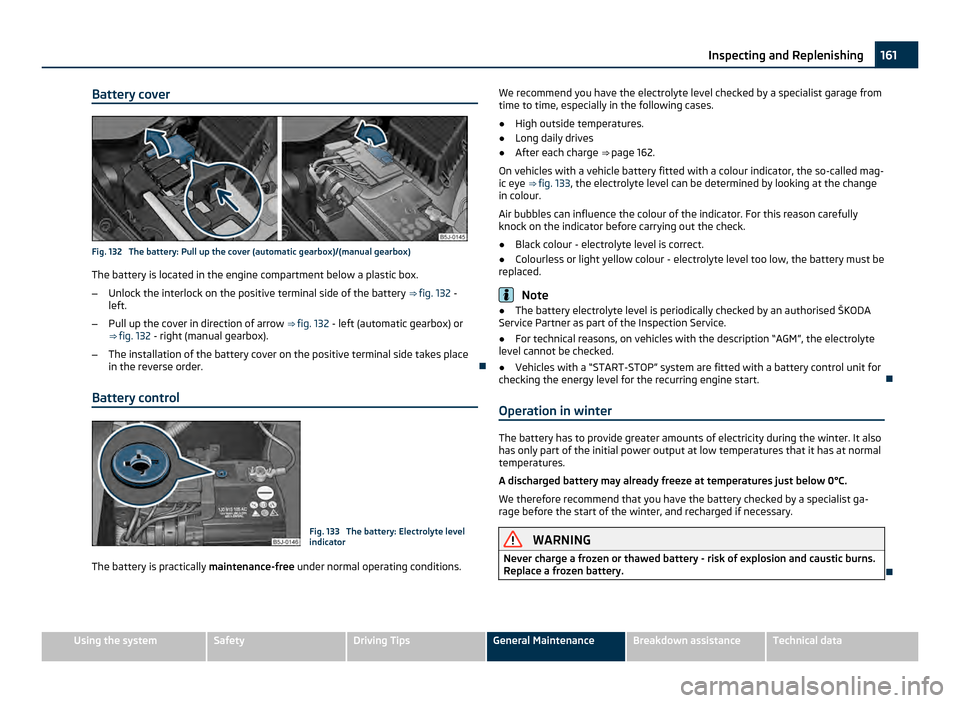
Battery cover
Fig. 132 The battery: Pull up the cover (automatic gearbox)/(manual gearbox)
The battery is located in the engine compartment below a plastic box.
– Unlock the interlock on the positive terminal side of the battery ⇒ fig. 132 -
left.
– Pull up the cover in direction of arrow ⇒ fig. 132
- left (automatic gearbox) or
⇒ fig. 132 - right (manual gearbox).
– The installation of the battery cover on the positive terminal side takes place
in the reverse order.
Battery control Fig. 133 The battery: Electrolyte level
indicator
The battery is practically maintenance-free under normal operating conditions. We recommend you have the electrolyte level checked by a specialist garage from
time to time, especially in the following cases.
●
High outside temperatures.
● Long daily drives
● After each charge ⇒
page 162.
On vehicles with a vehicle battery fitted with a colour indicator, the so-called mag-
ic eye ⇒
fig. 133 , the electrolyte level can be determined by looking at the change
in colour.
Air bubbles can influence the colour of the indicator. For this reason carefully
knock on the indicator before carrying out the check.
● Black colour - electrolyte level is correct.
● Colourless or light yellow colour - electrolyte level too low, the battery must be
replaced. Note
● The battery electrolyte level is periodically checked by an authorised ŠKODA
Service Partner as part of the Inspection Service.
● For technical reasons, on vehicles with the description
“AGM”, the electrolyte
level cannot be checked.
● Vehicles with a “START-STOP” system are fitted with a battery control unit for
checking the energy level for the recurring engine start.
Operation in winter The battery has to provide greater amounts of electricity during the winter. It also
has only part of the initial power output at low temperatures that it has at normal
temperatures.
A discharged battery may already freeze at temperatures just below 0°C.
We therefore recommend that you have the battery checked by a specialist ga-
rage before the start of the winter, and recharged if necessary.
WARNING
Never charge a frozen or thawed battery - risk of explosion and caustic burns.
Replace a frozen battery. 161
Inspecting and Replenishing Using the system Safety Driving Tips General Maintenance Breakdown assistance Technical data
Page 164 of 220
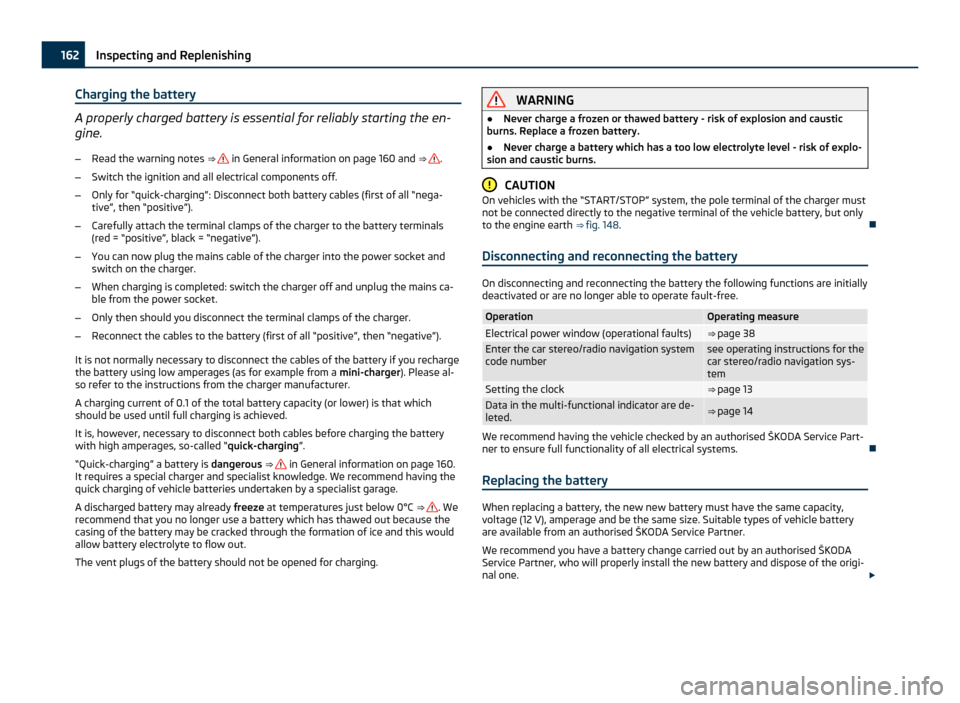
Charging the battery
A properly charged battery is essential for reliably starting the en-
gine.
– Read the warning notes ⇒ in General information on page 160 and ⇒ .
– Switch the ignition and all electrical components off.
– Only for “quick-charging”: Disconnect both battery cables (first of all “nega-
tive ”, then
“positive”).
– Carefully attach the terminal clamps of the charger to the battery terminals
(red = “positive”, black = “negative
”).
– You can now plug the mains cable of the charger into the power socket and
switch on the charger.
– When charging is completed: switch the charger off and unplug the mains ca-
ble from the power socket.
– Only then should you disconnect the terminal clamps of the charger.
– Reconnect the cables to the battery (first of all “positive”, then “negative”).
It is not normally necessary to disconnect the cables of the battery if you recharge
the battery using low amperages (as for example from a mini-charger). Please al-
so refer to the instructions from the charger manufacturer.
A charging current of 0.1 of the total battery capacity (or lower) is that which
should be used until full charging is achieved.
It is, however, necessary to disconnect both cables before charging the battery
with high amperages, so-called “ quick-charging”.
“Quick-charging
” a battery is dangerous ⇒ in General information on page 160.
It requires a special charger and specialist knowledge. We recommend having the
quick charging of vehicle batteries undertaken by a specialist garage.
A discharged battery may already freeze at temperatures just below 0°C ⇒ . We
recommend that you no longer use a battery which has thawed out because the
casing of the battery may be cracked through the formation of ice and this would
allow battery electrolyte to flow out.
The vent plugs of the battery should not be opened for charging. WARNING
● Never charge a frozen or thawed battery - risk of explosion and caustic
burns. Replace a frozen battery.
● Never charge a battery which has a too low electrolyte level - risk of explo-
sion and caustic burns. CAUTION
On vehicles with the “START/STOP” system, the pole terminal of the charger must
not be connected directly to the negative terminal of the vehicle battery, but only
to the engine earth ⇒ fig. 148.
Disconnecting and reconnecting the battery On disconnecting and reconnecting the battery the following functions are initially
deactivated or are no longer able to operate fault-free.
Operation Operating measure
Electrical power window (operational faults) ⇒ page 38
Enter the car stereo/radio navigation system
code number see operating instructions for the
car stereo/radio navigation sys-
tem
Setting the clock ⇒ page 13
Data in the multi-functional indicator are de-
leted.
⇒ page 14
We recommend having the vehicle checked by an authorised ŠKODA Service Part-
ner to ensure full functionality of all electrical systems.
Replacing the battery When replacing a battery, the new new battery must have the same capacity,
voltage (12
V), amperage and be the same size. Suitable types of vehicle battery
are available from an authorised ŠKODA Service Partner.
We recommend you have a battery change carried out by an authorised ŠKODA
Service Partner, who will properly install the new battery and dispose of the origi-
nal one. £162
Inspecting and Replenishing
Page 165 of 220
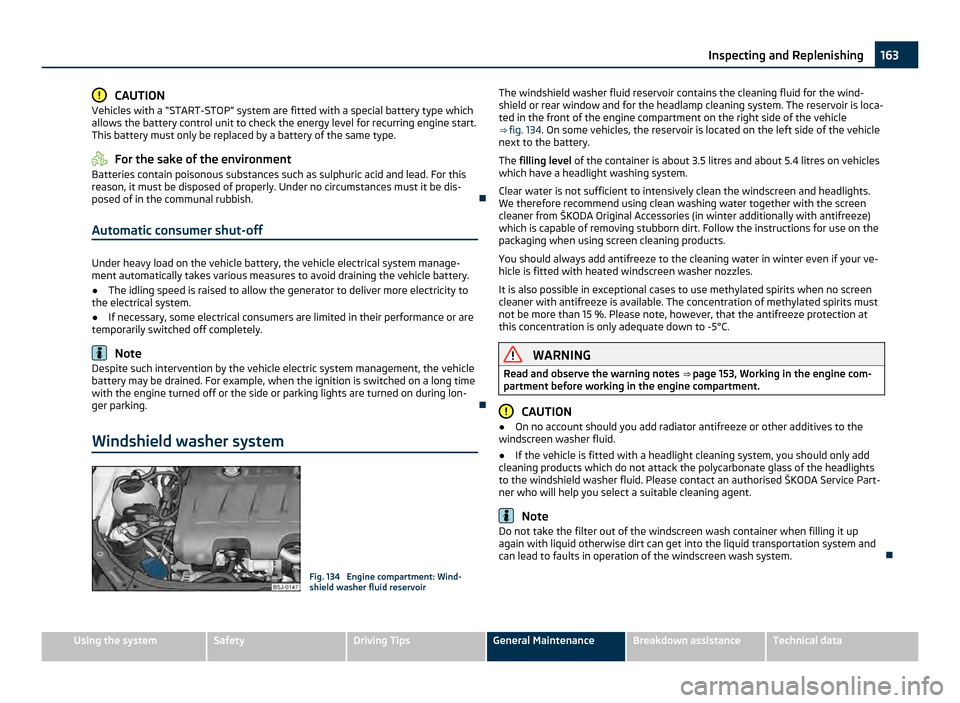
CAUTION
Vehicles with a “START-STOP” system are fitted with a special battery type which
allows the battery control unit to check the energy level for recurring engine start.
This battery must only be replaced by a battery of the same type. For the sake of the environment
Batteries contain poisonous substances such as sulphuric acid and lead. For this
reason, it must be disposed of properly. Under no circumstances must it be dis-
posed of in the communal rubbish.
Automatic consumer shut-off Under heavy load on the vehicle battery, the vehicle electrical system manage-
ment automatically takes various measures to avoid draining the vehicle battery.
●
The idling speed is raised to allow the generator to deliver more electricity to
the electrical system.
● If necessary, some electrical consumers are limited in their performance or are
temporarily switched off completely. Note
Despite such intervention by the vehicle electric system management, the vehicle
battery may be drained. For example, when the ignition is switched on a long time
with the engine turned off or the side or parking lights are turned on during lon-
ger parking.
Windshield washer system Fig. 134 Engine compartment: Wind-
shield washer fluid reservoirThe windshield washer fluid reservoir contains the cleaning fluid for the wind-
shield or rear window and for the headlamp cleaning system. The reservoir is loca-
ted in the front of the engine compartment on the right side of the vehicle
⇒ fig. 134. On some vehicles, the reservoir is located on the left side of the vehicle
next to the battery.
The filling level
of the container is about 3.5 litres and about 5.4 litres on vehicles
which have a headlight washing system.
Clear water is not sufficient to intensively clean the windscreen and headlights.
We therefore recommend using clean washing water together with the screen
cleaner from ŠKODA Original Accessories (in winter additionally with antifreeze)
which is capable of removing stubborn dirt. Follow the instructions for use on the
packaging when using screen cleaning products.
You should always add antifreeze to the cleaning water in winter even if your ve-
hicle is fitted with heated windscreen washer nozzles.
It is also possible in exceptional cases to use methylated spirits when no screen
cleaner with antifreeze is available. The concentration of methylated spirits must
not be more than 15 %. Please note, however, that the antifreeze protection at
this concentration is only adequate down to -5°C. WARNING
Read and observe the warning notes ⇒ page 153, Working in the engine com-
partment before working in the engine compartment. CAUTION
● On no account should you add radiator antifreeze or other additives to the
windscreen washer fluid.
● If the vehicle is fitted with a headlight cleaning system, you should only add
cleaning products which do not attack the polycarbonate glass of the headlights
to the windshield washer fluid. Please contact an authorised ŠKODA
Service Part-
ner who will help you select a suitable cleaning agent. Note
Do not take the filter out of the windscreen wash container when filling it up
again with liquid otherwise dirt can get into the liquid transportation system and
can lead to faults in operation of the windscreen wash system. 163
Inspecting and Replenishing Using the system Safety Driving Tips General Maintenance Breakdown assistance Technical data
Page 181 of 220
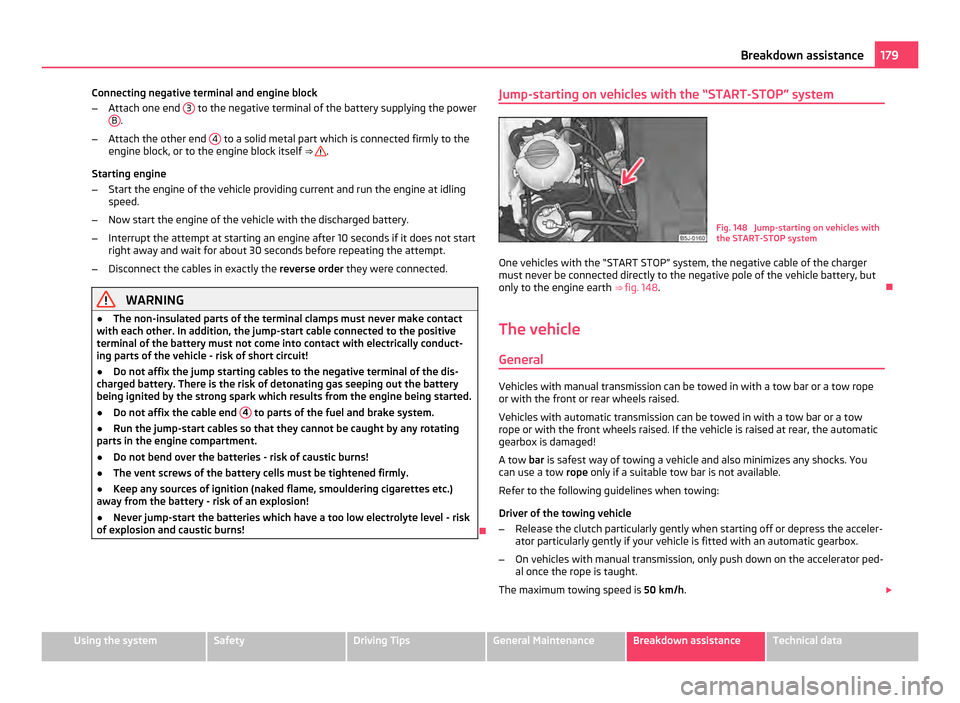
Connecting negative terminal and engine block
–
Attach one end 3 to the negative terminal of the battery supplying the power
B .
– Attach the other end 4 to a solid metal part which is connected firmly to the
engine block, or to the engine block itself ⇒ .
Starting engine
– Start the engine of the vehicle providing current and run the engine at idling
speed.
– Now start the engine of the vehicle with the discharged battery.
– Interrupt the attempt at starting an engine after 10 seconds if it does not start
right away and wait for about 30 seconds before repeating the attempt.
– Disconnect the cables in exactly the reverse order they were connected. WARNING
● The non-insulated parts of the terminal clamps must never make contact
with each other. In addition, the jump-start cable connected to the positive
terminal of the battery must not come into contact with electrically conduct-
ing parts of the vehicle - risk of short circuit!
● Do not affix the jump starting cables to the negative terminal of the dis-
charged battery. There is the risk of detonating gas seeping out the battery
being ignited by the strong spark which results from the engine being started.
● Do not affix the cable end 4 to parts of the fuel and brake system.
● Run the jump-start cables so that they cannot be caught by any rotating
parts in the engine compartment.
● Do not bend over the batteries - risk of caustic burns!
● The vent screws of the battery cells must be tightened firmly.
● Keep any sources of ignition (naked flame, smouldering cigarettes etc.)
away from the battery - risk of an explosion!
● Never jump-start the batteries which have a too low electrolyte level - risk
of explosion and caustic burns! Jump-starting on vehicles with the “START-STOP” system
Fig. 148 Jump-starting on vehicles with
the START-STOP system
One vehicles with the “START STOP” system, the negative cable of the charger
must never be connected directly to the negative pole of the vehicle battery, but
only to the engine earth ⇒ fig. 148.
The vehicle General Vehicles with manual transmission can be towed in with a tow bar or a tow rope
or with the front or rear wheels raised.
Vehicles with automatic transmission can be towed in with a tow bar or a tow
rope or with the front wheels raised. If the vehicle is raised at rear, the automatic gearbox is damaged!
A tow bar is safest way of towing a vehicle and also minimizes any shocks. You
can use a tow rope only if a suitable tow bar is not available.
Refer to the following guidelines when towing:
Driver of the towing vehicle
– Release the clutch particularly gently when starting off or depress the acceler-
ator particularly gently if your vehicle is fitted with an automatic gearbox.
– On vehicles with manual transmission, only push down on the accelerator ped-
al once the rope is taught.
The maximum towing speed is 50 km/h. £ 179
Breakdown assistance Using the system Safety Driving Tips General Maintenance Breakdown assistance Technical data
Page 182 of 220

Driver of the towed vehicle
–
Switch the ignition on so that the steering wheel is not blocked and you can
also operate the turn signal lights, the headlight flasher, the windscreen wip-
ers and windscreen washer system.
– Take the vehicle out of gear or move the selector lever into position N if your
vehicle is fitted with an automatic gearbox.
Note that the brake servo unit and power steering only operate if the engine is
running. You will require significantly greater physical force to depress the brake
pedal and to steer the vehicle if the engine is not running.
Ensure that the tow rope is always kept taught. CAUTION
● Do not tow start the engine - danger of damaging the engine. On vehicles with
a catalytic converter, unburnt fuel may get into the catalytic converter where it
may ignite. This in turn may damage or destroy the catalytic converter. You can
use the battery of another vehicle as a jump-start aid ⇒ page 178, Jump-starting.
● If the gearbox of your vehicle no longer contains any oil because of a defect,
your vehicle must only be towed in with the driven wheels raised clear of the
ground, or on a special vehicle transporter or trailer.
● The vehicle must be transported on a special vehicle or trailer if it is not possi-
ble to tow in the vehicle in the way described or if the towing distance is greater
than 50 km.
● To protect both vehicles when tow-starting or towing, the tow rope should be
elastic. Thus one should only use plastic fibre rope or a rope made out of a similar-
ly elastic material.
● One should be constantly vigilant not to allow impermissibly high towing
forces or jerky loadings. There is always a risk of excessive stresses and damage
resulting at the points to which you attach the tow rope or tow bar when you at-
tempt to tow a vehicle which is not standing on a paved road.
● Attach the tow rope or the tow bar only to the towing eyes
provided for this
purpose ⇒ page 180,
Front towing eye and ⇒ page 181, Rear towing eye.Note
● We recommend a tow rope from the range of ŠKODA Original Accessories that
you can purchase from an authorised
ŠKODA Service Partner.
● Towing another vehicle requires a certain amount of practice. Both drivers
should be familiar with the particular points about towing a vehicle. Unskilled driv-
ers should not attempt to tow in another vehicle or to be towed in. ●
When towing, respect the national legal provisions, especially those which re-
late to the identification of the towing vehicle and the vehicle being towed.
● The tow rope must not be twisted as it may in certain circumstances result in
the front towing eye being unscrewed out of your vehicle.
Front towing eye The towing eye is stored in the box of the vehicle tool kit.
Fig. 149 Front bumper: Cover/installing the towing eye
–
Press on the left half of the cover at the point of the arrow ⇒
fig. 149 - left.
– Pull the cover out of the front bumper.
– Screw in the towing eye by hand to the left up to the stop ⇒ fig. 149 - right. For
tightening, we recommend that you use for example the wheel wrench, the
lashing eye of another vehicle or a similar object which you can push through
the eye.
– In order to reinstall the cover after screwing out the towing eye, insert it in the
mounts and then press on the right side of the cover. The cover must engage
firmly. CAUTION
The towing eye must always be screwed in fully and firmly tightened, otherwise
the towing eye can tear when towing. 180
Breakdown assistance
Page 185 of 220
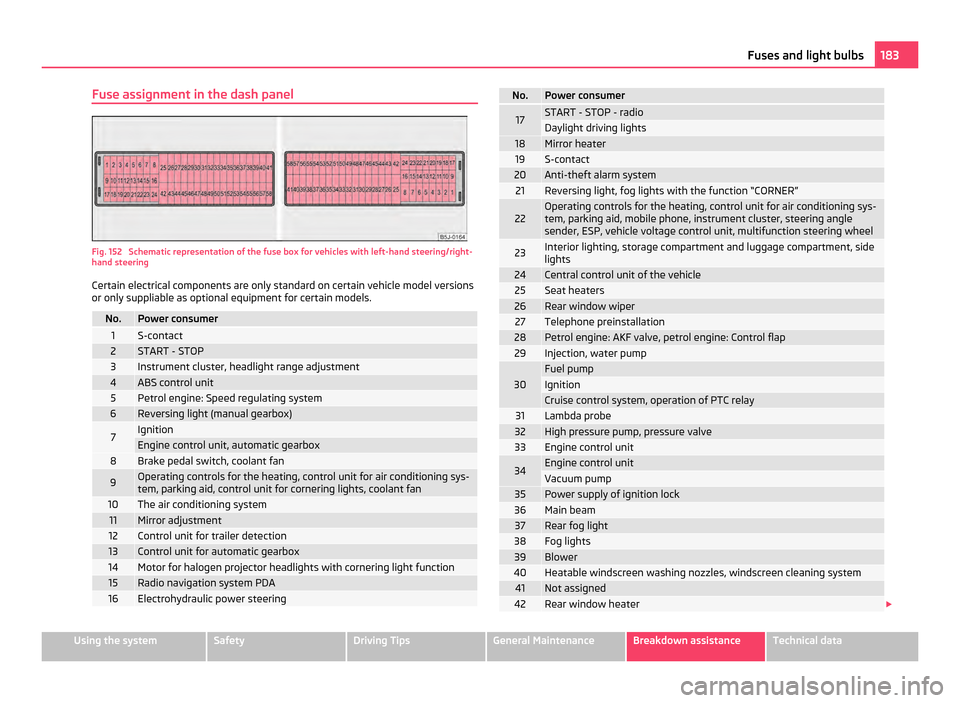
Fuse assignment in the dash panel
Fig. 152 Schematic representation of the fuse box for vehicles with left-hand steering/right-
hand steering
Certain electrical components are only standard on certain vehicle model versions
or only suppliable as optional equipment for certain models. No. Power consumer
1 S-contact
2 START - STOP
3 Instrument cluster, headlight range adjustment
4 ABS control unit
5 Petrol engine: Speed regulating system
6 Reversing light (manual gearbox)
7 Ignition
Engine control unit, automatic gearbox
8 Brake pedal switch, coolant fan
9 Operating controls for the heating, control unit for air conditioning sys-
tem, parking aid, control unit for cornering lights, coolant fan
10 The air conditioning system
11 Mirror adjustment
12 Control unit for trailer detection
13 Control unit for automatic gearbox
14 Motor for halogen projector headlights with cornering light function
15 Radio navigation system PDA
16 Electrohydraulic power steering No. Power consumer
17 START - STOP - radio
Daylight driving lights
18 Mirror heater
19 S-contact
20 Anti-theft alarm system
21 Reversing light, fog lights with the function “CORNER”
22 Operating controls for the heating, control unit for air conditioning sys-
tem, parking aid, mobile phone, instrument cluster, steering angle
sender, ESP, vehicle voltage control unit, multifunction steering wheel
23 Interior lighting, storage compartment and luggage compartment, side
lights
24 Central control unit of the vehicle
25 Seat heaters
26 Rear window wiper
27 Telephone preinstallation
28 Petrol engine: AKF valve, petrol engine: Control flap
29 Injection, water pump
30 Fuel pump
Ignition
Cruise control system, operation of PTC relay
31 Lambda probe
32 High pressure pump, pressure valve
33 Engine control unit
34 Engine control unit
Vacuum pump
35 Power supply of ignition lock
36 Main beam
37 Rear fog light
38 Fog lights
39 Blower
40 Heatable windscreen washing nozzles, windscreen cleaning system
41 Not assigned
42 Rear window heater
£ 183
Fuses and light bulbs Using the system Safety Driving Tips General Maintenance Breakdown assistance Technical data
Page 186 of 220
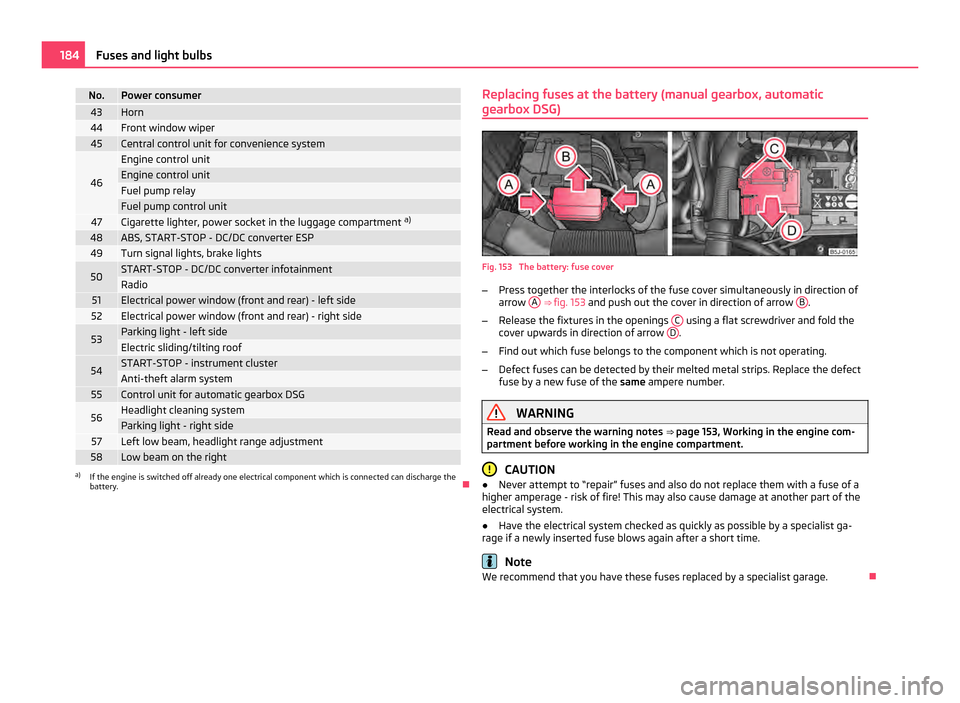
No. Power consumer
43 Horn
44 Front window wiper
45 Central control unit for convenience system
46 Engine control unit
Engine control unit
Fuel pump relay
Fuel pump control unit
47 Cigarette lighter, power socket in the luggage compartment
a)48 ABS, START-STOP - DC/DC converter ESP
49 Turn signal lights, brake lights
50 START-STOP - DC/DC converter infotainment
Radio
51 Electrical power window (front and rear) - left side
52 Electrical power window (front and rear) - right side
53 Parking light - left side
Electric sliding/tilting roof
54 START-STOP - instrument cluster
Anti-theft alarm system
55 Control unit for automatic gearbox DSG
56 Headlight cleaning system
Parking light - right side
57 Left low beam, headlight range adjustment
58 Low beam on the right
a)
If the engine is switched off already one electrical component which is connected can discharge the
battery. Replacing fuses at the battery (manual gearbox, automatic
gearbox DSG) Fig. 153 The battery: fuse cover
– Press together the interlocks of the fuse cover simultaneously in direction of
arrow A ⇒ fig. 153 and push out the cover in direction of arrow
B .
– Release the fixtures in the openings C using a flat screwdriver and fold the
cover upwards in direction of arrow D .
– Find out which fuse belongs to the component which is not operating.
– Defect fuses can be detected by their melted metal strips. Replace the defect
fuse by a new fuse of the same ampere number. WARNING
Read and observe the warning notes ⇒ page 153, Working in the engine com-
partment before working in the engine compartment. CAUTION
● Never attempt to “
repair” fuses and also do not replace them with a fuse of a
higher amperage - risk of fire! This may also cause damage at another part of the
electrical system.
● Have the electrical system checked as quickly as possible by a specialist ga-
rage if a newly inserted fuse blows again after a short time. Note
We recommend that you have these fuses replaced by a specialist garage. 184
Fuses and light bulbs
Page 191 of 220
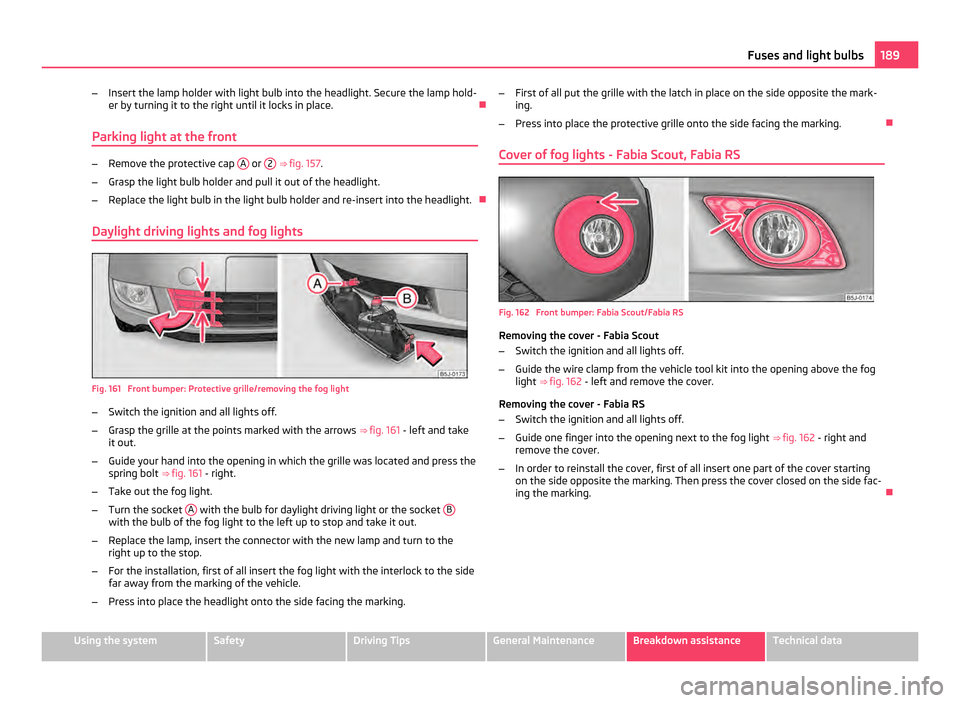
–
Insert the lamp holder with light bulb into the headlight. Secure the lamp hold-
er by turning it to the right until it locks in place.
Parking light at the front –
Remove the protective cap A or
2 ⇒
fig. 157 .
– Grasp the light bulb holder and pull it out of the headlight.
– Replace the light bulb in the light bulb holder and re-insert into the headlight.
Daylight driving lights and fog lights Fig. 161 Front bumper: Protective grille/removing the fog light
–
Switch the ignition and all lights off.
– Grasp the grille at the points marked with the arrows ⇒ fig. 161 - left and take
it out.
– Guide your hand into the opening in which the grille was located and press the
spring bolt ⇒
fig. 161 - right.
– Take out the fog light.
– Turn the socket A with the bulb for daylight driving light or the socket
Bwith the bulb of the fog light to the left up to stop and take it out.
– Replace the lamp, insert the connector with the new lamp and turn to the
right up to the stop.
– For the installation, first of all insert the fog light with the interlock to the side
far away from the marking of the vehicle.
– Press into place the headlight onto the side facing the marking. –
First of all put the grille with the latch in place on the side opposite the mark-
ing.
– Press into place the protective grille onto the side facing the marking.
Cover of fog lights - Fabia Scout, Fabia RS Fig. 162 Front bumper: Fabia Scout/Fabia RS
Removing the cover - Fabia Scout
–
Switch the ignition and all lights off.
– Guide the wire clamp from the vehicle tool kit into the opening above the fog
light ⇒ fig. 162 - left and remove the cover.
Removing the cover - Fabia RS
– Switch the ignition and all lights off.
– Guide one finger into the opening next to the fog light ⇒ fig. 162
- right and
remove the cover.
– In order to reinstall the cover, first of all insert one part of the cover starting
on the side opposite the marking. Then press the cover closed on the side fac-
ing the marking. 189
Fuses and light bulbs Using the system Safety Driving Tips General Maintenance Breakdown assistance Technical data
Page 210 of 220
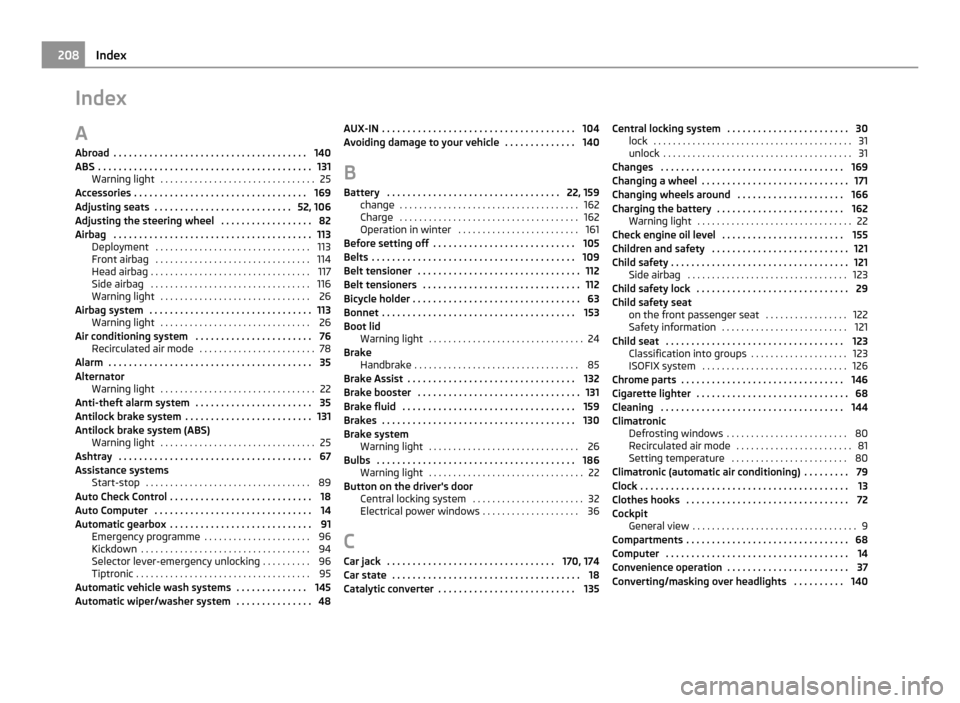
Index
A
Abroad . . . . . . . . . . . . . . . . . . . . . . . . . . . . . . . . . . . . . . 140
ABS
. . . . . . . . . . . . . . . . . . . . . . . . . . . . . . . . . . . . . . . . . . 131
Warning light . . . . . . . . . . . . . . . . . . . . . . . . . . . . . . . . 25
Accessories . . . . . . . . . . . . . . . . . . . . . . . . . . . . . . . . . . 169
Adjusting seats . . . . . . . . . . . . . . . . . . . . . . . . . . . 52, 106
Adjusting the steering wheel . . . . . . . . . . . . . . . . . . 82
Airbag . . . . . . . . . . . . . . . . . . . . . . . . . . . . . . . . . . . . . . . 113 Deployment . . . . . . . . . . . . . . . . . . . . . . . . . . . . . . . . 113
Front airbag . . . . . . . . . . . . . . . . . . . . . . . . . . . . . . . . 114
Head airbag . . . . . . . . . . . . . . . . . . . . . . . . . . . . . . . . . 117
Side airbag . . . . . . . . . . . . . . . . . . . . . . . . . . . . . . . . . 116
Warning light . . . . . . . . . . . . . . . . . . . . . . . . . . . . . . . 26
Airbag system . . . . . . . . . . . . . . . . . . . . . . . . . . . . . . . . 113 Warning light . . . . . . . . . . . . . . . . . . . . . . . . . . . . . . . 26
Air conditioning system . . . . . . . . . . . . . . . . . . . . . . . 76 Recirculated air mode . . . . . . . . . . . . . . . . . . . . . . . . 78
Alarm . . . . . . . . . . . . . . . . . . . . . . . . . . . . . . . . . . . . . . . . 35
Alternator Warning light . . . . . . . . . . . . . . . . . . . . . . . . . . . . . . . . 22
Anti-theft alarm system . . . . . . . . . . . . . . . . . . . . . . . 35
Antilock brake system . . . . . . . . . . . . . . . . . . . . . . . . . 131
Antilock brake system (ABS) Warning light . . . . . . . . . . . . . . . . . . . . . . . . . . . . . . . . 25
Ashtray . . . . . . . . . . . . . . . . . . . . . . . . . . . . . . . . . . . . . . 67
Assistance systems Start-stop . . . . . . . . . . . . . . . . . . . . . . . . . . . . . . . . . . 89
Auto Check Control . . . . . . . . . . . . . . . . . . . . . . . . . . . . 18
Auto Computer . . . . . . . . . . . . . . . . . . . . . . . . . . . . . . . 14
Automatic gearbox . . . . . . . . . . . . . . . . . . . . . . . . . . . . 91 Emergency programme . . . . . . . . . . . . . . . . . . . . . . 96
Kickdown . . . . . . . . . . . . . . . . . . . . . . . . . . . . . . . . . . . 94
Selector lever-emergency unlocking . . . . . . . . . . 96
Tiptronic . . . . . . . . . . . . . . . . . . . . . . . . . . . . . . . . . . . . 95
Automatic vehicle wash systems . . . . . . . . . . . . . . 145
Automatic wiper/washer system . . . . . . . . . . . . . . . 48 AUX-IN . . . . . . . . . . . . . . . . . . . . . . . . . . . . . . . . . . . . . . 104
Avoiding damage to your vehicle
. . . . . . . . . . . . . .
140
B
Battery . . . . . . . . . . . . . . . . . . . . . . . . . . . . . . . . . . 22, 159 change . . . . . . . . . . . . . . . . . . . . . . . . . . . . . . . . . . . . . 162
Charge . . . . . . . . . . . . . . . . . . . . . . . . . . . . . . . . . . . . . 162
Operation in winter . . . . . . . . . . . . . . . . . . . . . . . . . 161
Before setting off . . . . . . . . . . . . . . . . . . . . . . . . . . . . 105
Belts . . . . . . . . . . . . . . . . . . . . . . . . . . . . . . . . . . . . . . . . 109
Belt tensioner . . . . . . . . . . . . . . . . . . . . . . . . . . . . . . . . 112
Belt tensioners . . . . . . . . . . . . . . . . . . . . . . . . . . . . . . . 112
Bicycle holder . . . . . . . . . . . . . . . . . . . . . . . . . . . . . . . . . 63
Bonnet . . . . . . . . . . . . . . . . . . . . . . . . . . . . . . . . . . . . . . 153
Boot lid Warning light . . . . . . . . . . . . . . . . . . . . . . . . . . . . . . . . 24
Brake Handbrake . . . . . . . . . . . . . . . . . . . . . . . . . . . . . . . . . . 85
Brake Assist . . . . . . . . . . . . . . . . . . . . . . . . . . . . . . . . . 132
Brake booster . . . . . . . . . . . . . . . . . . . . . . . . . . . . . . . . 131
Brake fluid . . . . . . . . . . . . . . . . . . . . . . . . . . . . . . . . . . 159
Brakes . . . . . . . . . . . . . . . . . . . . . . . . . . . . . . . . . . . . . . 130
Brake system Warning light . . . . . . . . . . . . . . . . . . . . . . . . . . . . . . . 26
Bulbs . . . . . . . . . . . . . . . . . . . . . . . . . . . . . . . . . . . . . . . 186 Warning light . . . . . . . . . . . . . . . . . . . . . . . . . . . . . . . . 22
Button on the driver's door Central locking system . . . . . . . . . . . . . . . . . . . . . . . 32
Electrical power windows . . . . . . . . . . . . . . . . . . . . 36
C Car jack . . . . . . . . . . . . . . . . . . . . . . . . . . . . . . . . . 170, 174
Car state . . . . . . . . . . . . . . . . . . . . . . . . . . . . . . . . . . . . . 18
Catalytic converter . . . . . . . . . . . . . . . . . . . . . . . . . . . 135 Central locking system . . . . . . . . . . . . . . . . . . . . . . . . 30
lock . . . . . . . . . . . . . . . . . . . . . . . . . . . . . . . . . . . . . . . . . 31
unlock
. . . . . . . . . . . . . . . . . . . . . . . . . . . . . . . . . . . . . . . 31
Changes . . . . . . . . . . . . . . . . . . . . . . . . . . . . . . . . . . . . 169
Changing a wheel . . . . . . . . . . . . . . . . . . . . . . . . . . . . . 171
Changing wheels around . . . . . . . . . . . . . . . . . . . . . 166
Charging the battery . . . . . . . . . . . . . . . . . . . . . . . . . 162 Warning light . . . . . . . . . . . . . . . . . . . . . . . . . . . . . . . . 22
Check engine oil level . . . . . . . . . . . . . . . . . . . . . . . . 155
Children and safety . . . . . . . . . . . . . . . . . . . . . . . . . . . 121
Child safety . . . . . . . . . . . . . . . . . . . . . . . . . . . . . . . . . . . 121 Side airbag . . . . . . . . . . . . . . . . . . . . . . . . . . . . . . . . . 123
Child safety lock . . . . . . . . . . . . . . . . . . . . . . . . . . . . . . 29
Child safety seat on the front passenger seat . . . . . . . . . . . . . . . . . 122
Safety information . . . . . . . . . . . . . . . . . . . . . . . . . . 121
Child seat . . . . . . . . . . . . . . . . . . . . . . . . . . . . . . . . . . . 123 Classification into groups . . . . . . . . . . . . . . . . . . . . 123
ISOFIX system . . . . . . . . . . . . . . . . . . . . . . . . . . . . . . 126
Chrome parts . . . . . . . . . . . . . . . . . . . . . . . . . . . . . . . . 146
Cigarette lighter . . . . . . . . . . . . . . . . . . . . . . . . . . . . . . 68
Cleaning . . . . . . . . . . . . . . . . . . . . . . . . . . . . . . . . . . . . 144
Climatronic Defrosting windows . . . . . . . . . . . . . . . . . . . . . . . . . 80
Recirculated air mode . . . . . . . . . . . . . . . . . . . . . . . . 81
Setting temperature . . . . . . . . . . . . . . . . . . . . . . . . 80
Climatronic (automatic air conditioning) . . . . . . . . . 79
Clock . . . . . . . . . . . . . . . . . . . . . . . . . . . . . . . . . . . . . . . . . 13
Clothes hooks . . . . . . . . . . . . . . . . . . . . . . . . . . . . . . . . 72
Cockpit General view . . . . . . . . . . . . . . . . . . . . . . . . . . . . . . . . . . 9
Compartments . . . . . . . . . . . . . . . . . . . . . . . . . . . . . . . . 68
Computer . . . . . . . . . . . . . . . . . . . . . . . . . . . . . . . . . . . . 14
Convenience operation . . . . . . . . . . . . . . . . . . . . . . . . 37
Converting/masking over headlights . . . . . . . . . . 140 208
Index